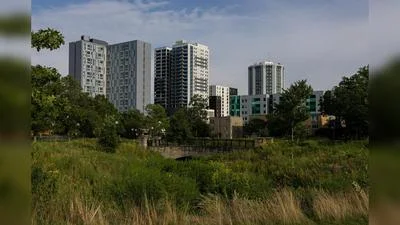City of Urbana Bicycle and Pedestrian Advisory Committee met Oct. 10.
Here is the minutes provided by the Committee:
Members Present: Bill Brown (Chair), Kara Dudek, Cynthia Hoyle Audrey Ishii, Jeff Marino, Craig Shonkwiler Nancy Westcott and Lily Wilcock.
Staff Present: Brad Bennett, Kevin Garcia
Members Absent: Leonardo Covis, Susan Jones
Members Late Arrival: Annie Adams
Others Present:
Rita Morocoima-Black, Champaign County Regional Planning Commission Gabe Lewis, Champaign County Regional Planning Commission Lori Morgan, Champaign County Regional Planning Commission Ammar Elmajdoub, University of Illinois Graduate Student Miles Churchill, University of Illinois Graduate Student
1. CALL TO ORDER, ROLL CALL, AND DECLARATION OF QUORUM
Bill Brown called the meeting to order at 7:01 p.m. Roll call was taken. It was noted that a quorum of members was present.
2. PUBLIC INPUT
There was no public input.
3. FORMER BUSINESS: To Discuss Goals and Objectives for the Pedestrian Master Plan with the Champaign County Regional Planning Commission
i. Public Input Report
Bill Brown stated that the purpose of this meeting was to set goals and objectives for the Urbana Pedestrian Master Plan (UPMP).
Gabe Lewis stated that he would be the project planner for the UPMP. Prior to discussing the goals and objectives, Mr. Lewis wanted to update the Commission on the public input report done in the spring. He added that the report incorporated comments from City Staff and the Commission.
Gabe Lewis elaborated on a question from the Commission on where input was received from during the multiple neighborhood meetings. An additional request by the Commission was to show the actual number of responses to questions in a table format (i.e. Q7 Roads) along with the graphic illustration that had already been provided in the draft. Gabe Lewis also stated that trip activity maps were now included along with the neighborhood maps. He added that the information would be available on the CCRPC website.
Craig Shonkwiler asked whether any additional data came out of the survey with the comments provided by the Commission.
Gabe Lewis stated that more problems were seen with the north/south streets. Rita Morocoima-Black added that they were surprised with answers to the problem streets questions and responded with north/south streets. The main problematic streets listed were Lincoln Avenue, Race Street and Vine Street. She added that the only east/west street listed as problematic was University Avenue and that Florida Avenue, Main Street, Windsor Avenue and Washington Street did not have any negative comments.
i. Existing Conditions
Gabe Lewis asked for any comments or questions regarding the existing conditions report from the Commission.
Lily Wilcock asked whether the existing conditions report would be sent to the Campus Master Plan Committee specifically in regards to the importance with respect to Lincoln Avenue and University Avenue.
Gabe Lewis answered that the public report will be posted for viewing on their website and can be shared. Rita Morocoima-Black added that nothing else would be provided since it is not final.
In response to Bill Brown, Gabe Lewis gave a completion timeline. He stated that the draft plan would be prepared in the winter, followed by a 30 day public comment, then to the Commission for review and finally to City Council for review. Ms. Black stated it would be approximately 6-9 months. Brad Bennett reminded the Commission of the 18 month estimation for completion of the plan.
In response to Annie Adams question about how the policy would be implemented, Rita Morocoima-Black stated that there would be policy recommendations which may include policies for the whole city or for spot recommendation for locations identified as highly problematic.
Audrey Ishii asked the question on whether the plan would follow the Urbana Bicycle Master Plan (UBMP) goal of vision zero. Ms. Black agreed that they would it would favor the safety pillar of the UBMP.
Gabe Lewis elaborated on the comments about lighting issues. He stated that it went both ways where people either wanted improved lighting or did not to maintain a dark sky.
A question was posed by Cynthia Hoyle about an existing condition crashes at Lincoln Avenue and Ohio Street. Craig Shonkwiler stated that the City was aware of that incident and a study from Pennsylvania to Nevada while Ohio and Iowa are focal points. ii.
Planning Pillars, Goals and Objectives
Following the October 10, 2017 Urbana BPAC meeting, these were the planning pillars that CCRPC staff, the City, and Commission would now be working with:
a. Accessibility and Connectivity
b. Equity
c. Safety
d. Vibrancy
Following were the discussion points regarding planning pillars at the October 10, 2017 BPAC meeting.
Annie Adams:
o Creating connections between safe, low-stress and interesting streets for walking in Urbana.
o Just because you can walk somewhere doesn’t mean you want to (e.g. University Avenue.
o 7 planning pillars is a lot.
o User Experience
o Quality of Life
o With Tim Nugent passing, we should call out some information in the plan’s background section:
Walking is in Urbana’s DNA. We believe in accessibility, mobility, and fair infrastructure.
Tim Nugent changed people’s lives.
o Engaging and inviting
Audrey Ishii:
o Incorporate Vision Zero into this plan.
o Policy for behavioral intervention = Safety.
o One metric (i.e. performance measure) should be pedestrian counts.
o “Attractive”
o Trees slow down cars.
o University Avenue is a “river of death” – could be a community making place instead.
Bill Brown:
o Lighting can help pedestrians avoid physical barriers on sidewalks at night.
o Likes “Site Design.”
o Incorporate Age Friendly Community information into this plan.
o Obesity is measurable.
o Mental health is important, but we need to find ways to measure it.
Craig Shonkwiler:
o Land use and site design – cited in Bellingham, WA’s pedestrian plan.
o This plan could help the City of Urbana work with developers and new developments to address pedestrian access issues.
Cynthia Hoyle:
o Urbana should aim to achieve recognition as a Walk Friendly Community.
o Equity should be a high priority.
o Safety is first.
o Sustainability may not fit as a goal for this plan.
There was consensus about at least changing the word for this, and BPAC ultimately removed this is as a planning pillar.
o The Urban Land Institute cites eight qualities of Pedestrian- and Transit-Oriented Design:
Imageability (distinct place/destinations)
Enclosure
Human Scale
Transparency
Complexity
Coherence
Legibility
Linkage
o We need to talk about the context about why people are walking.
o User Friendliness and Equity go together.
o Look at the Bellingham, WA Pedestrian Plan.
o Yes, encouragement strategies impact health (e.g. Park Rx program).
o Olathe, KS development site design is a model to look at.
Jeff Marino:
o Some goals are design oriented, and some goals are reasoning oriented. We need a justification of why we’re creating these strategies and goals.
o Look at zoning and subdivision regulations.
o Look at parking requirements.
Kara Dudek:
o We want to touch on how the natural environment makes your walk more enjoyable.
o Mental health benefits of walking.
o Urban design: what we’re doing is intentional.
Kevin Garcia:
o A guiding statement for this plan is that we want a pedestrian environment that is “safe, attractive, accessible, and convenient for everybody.”
o You could fill in planning pillars to guide the statement above.
o Targets vs. strategies.
Nancy Westcott:
o There may be different criteria for different types of streets (e.g. neighborhood vs. arterial).
Other Comments:
o Safety: trip hazards.
o Winter hazards: iced sidewalks, unshoveled sidewalks.
o Lincoln Avenue has some higher density residential development, even though the road itself is not pedestrian friendly.
o Seattle, WA Pedestrian Plan’s Goals:
Safety
Equity
Vibrancy
Health
o Incorporate “Education and Encouragement” throughout the new planning pillars.
Strategies can include using reflective vests, and items involving no cell phone use.
o Part of the vision could be to increase the number of people walking in the community.
o The new Vibrancy planning pillar should include or incorporate:
Health (physical, mental, psychological)
Environmental issues should be included, too.
Attractiveness can be included in this, as well.
Background Information:
Plan #1 Themes: 2014 Active Choices – Champaign County Greenways & Trails Plan
1. Accessibility
2. Connectivity
3. Safety
4. User-Friendliness
5. Efficiency
6. Mobility
7. Convenience
8. Natural Environment
9. Coordination
10. Implementation
11. Education
12. Promotion
13. Quality of Life
14. Health
Plan #2 Health Priorities: 2014 Champaign-Urbana Public Health District (CUPHD) Community Health Improvement Plan (IPLAN)
1. Access to Care
2. Behavioral Health
3. Obesity
4. Violence
Plan #3 Planning Pillars: 2014 Sustainable Choices – Long Range Transportation Plan (LRTP) 2040
1. Safety
2. Security
3. Balanced Development
4. Multimodal Connectivity
5. Accessibility
6. Affordability
7. Healthy Neighborhoods
8. Resilient Economy
Plan #4 Themes: 2016 Urbana Park District Trails Master Plan
1. Accessibility
2. Connectivity
3. Safety
4. User-Friendliness
5. Education
6. Natural Environment
7. Coordination
8. Implementation
Plan #5 Themes: 2016 Prairie Campus Safe Routes to School (SRTS) Plan
1. Increase the number of safe walking routes to school
2. Encouragement
Plan #6 Themes: 2016 Urbana Bicycle Master Plan (UBMP)
1. Safety
2. Connectivity
3. Convenience
4. Education
5. Equity
6. Implementation
7. Visionary Concepts
2017 Urbana Pedestrian Master Plan Public Input, frequently cited subjects:
1. Crossings
2. Maintenance
3. Major Streets
4. Neighborhoods
5. No Sidewalks
6. Parks
7. Safety
8. Sidewalks
9. Streets
All Pillars/Priorities/Subjects/Themes:
1. Safety (5 mentions)
2. Connectivity/Multimodal Connectivity (4 mentions)
3. Accessibility (3 mentions)
4. Education (3 mentions)
5. Implementation (3 mentions)
6. Convenience (2 mentions)
7. Coordination (2 mentions)
8. Health/Healthy Neighborhoods (2 mentions)
9. Natural Environment (2 mentions)
10. User-Friendliness (2 mentions)
11. Access to Care
12. Balanced Development
13. Behavioral Health
14. Crossings
15. Efficiency
16. Encouragement
17. Equity
18. Increase the number of safe walking routes to school
19. Maintenance
20. Major Streets
21. Mobility
22. Neighborhoods
23. No Sidewalks
24. Obesity
25. Parks
26. Promotion
27. Quality of Life
28. Resilient Economy
29. Security
30. Sidewalks
31. Streets
32. Violence
33. Visionary Concepts
UPMP Planning Pillars as of October 10, 2017:
Seven planning pillars were presented to BPAC at its
Reducing the risk of crashes between pedestrians and vehicles.
2. Accessibility and Connectivity
Accessibility = destinations, infrastructure.
Connectivity = connecting facilities and destinations within the pedestrian network.
3. Convenience and User-Friendliness
Convenience = making walking an easier transportation choice.
User-Friendliness = regarding features that improve walking or attract people to walk.
4. Education & Encouragement
For pedestrians, bicyclists, and motorists.
5. Health
Regarding increased physical activity and reduced obesity.
6. Sustainability
Regarding the natural environment and air quality.
7. Equity
Planning for all neighborhoods and people in Urbana, especially people who walk out of necessity.
iii. Next Steps
These planning pillars were the basis for the creation of goals, objectives, performance measures, and strategies. Commission members should send their ideas about these topics to CCRPC staff (Gabe Lewis – glewis@ccrpc.org) by Friday, October 27, 2017.
4. ADJOURNMENT
The meeting adjourned at 9:07 p.m.
https://www.urbanaillinois.us/sites/default/files/attachments/October%202017%20BPAC%20Special%20Meeting%20Minutes%20-%20Approved.pdf






 Alerts Sign-up
Alerts Sign-up